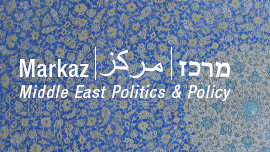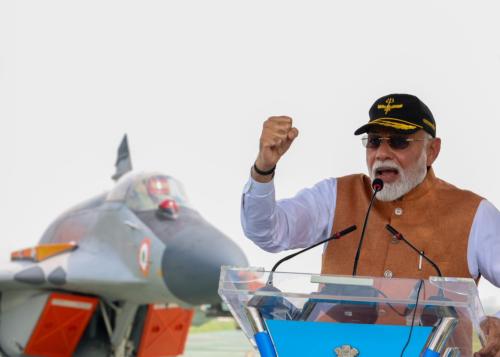Editor’s Note: Despite its successful terrorist attacks in Europe, the Islamic State is being hit hard in Iraq. Although kicking the Islamic State out of Mosul would be a true sign of progress, Joshua Rovner and Caitlin Talmadge offer some cautions. They point out that ultimate success will depend on who fights the battle, who rules after the peace, and how Mosul is integrated into overall U.S. planning. This post originally appeared on Lawfare.
ISIS is back on its heels in both Syria and Iraq, and the Iraqi government announced on March 24 that the all-important, yet much-delayed campaign to re-take the critical Iraqi city of Mosul has finally begun. Starting with attacks on towns south of the city, the campaign’s goal is to effect a “slow strangulation” of ISIS in Mosul, much as in the successful effort against ISIS in Ramadi last year.
Unfortunately, it is one thing to recognize that ISIS is becoming weaker, but quite another to exploit its weakness in a way that leads to a meaningful victory and a durable peace. Three crucial questions remain unanswered about the coming battle for Mosul and the larger implications for the United States and Iraq. Without good answers, even a vigorous campaign may deliver only marginal strategic results.
Who will fight the battle?
The Mosul campaign includes a hodge-podge of actors with varying interests, capabilities, and will to fight. It is a microcosm of the war as a whole.
Washington has been sending mixed signals about its own commitment to the battle. On the one hand, the Obama administration is careful to stress that it must be and will be an Iraqi-led effort. The president has repeatedly declared that he does not want U.S. forces in a large ground war resulting in an open-ended occupation of Iraq.
On the other hand, he has pledged the destruction of ISIS, as have all the presidential candidates. This suggests that the United States will settle for nothing less than a comprehensive victory. And given Mosul’s size and symbolic importance for ISIS, it is not hard to imagine that the United States will send additional U.S. forces if the Iraqi army fails. Indeed, the United States has already established a division headquarters in Iraq, which is a somewhat odd command arrangement for what amounts to a brigade-sized force. It has also committed a disproportionate number of generals to Iraq. Both of these decisions suggest that the United States has put in place the logistical backbone for a much larger surge of land forces if required.
The Mosul campaign includes a hodge-podge of actors with varying interests, capabilities, and will to fight. It is a microcosm of the war as a whole.
The Iraqi army has also sent mixed signals. Although its leaders have recently expressed confidence in their growing capabilities, there are real reasons to doubt them. The ISIS summer offensive in 2014 quickly routed the army in all areas except the Shi’a heartland in Baghdad and southern Iraq. Officers and soldiers showed little enthusiasm for fighting far from home. Efforts to improve their capabilities and inject new motivation have been halting at best since that time. The recent victories against ISIS resulted largely from action by Kurdish and Shi’a militias, U.S. airpower, and a small force of increasingly overworked elite Iraqi counterterrorism troops that were intensively trained by U.S. Green Berets—not from the efforts of conventional Iraqi forces. Indeed, one analyst has gone so far as to argue that the army itself is a fiction.
Turning the broken Iraqi army into a cohesive force will be especially difficult, because the Iraqi government has a long history of deliberately undermining battlefield effectiveness in order to protect against coups. In the past, this has meant restricting realistic combat training and inhibiting communication among talented commanders, while promoting officers based on loyalty rather than competence and ensuring sectarian homogeneity among the officer corps. It is difficult to overcome the legacy of these efforts. And while there are historical precedents for turning around deeply politicized militaries, this is a particularly hard test because it requires a largely Shi’a army to fight in an overwhelmingly Sunni city.
Kurdish fighters have similarly proven very effective—and quite ruthless—in their defense of Kurdish strongholds, and the operational plan for Mosul relies heavily on Kurdish support. Indeed, the current offensive against Qayyarah is being launched from Kurdish-held Makhmour, and Kurds are expected to cut off ISIS’ escape routes to the north and west of the city. But strangling a desperate ISIS force may require close combat with desperate ISIS fighters, and as Sun Tzu reminds us, no one fights harder than those on “death ground.” Whether the Kurds are willing to fight back in those circumstances, especially if they have no expectation of being able to keep territory they die to re-take, is an open question.
Indigenous and Iranian-backed Shi’a militia may also take part in the fight, much as they did during the recapture of Tikrit last year. At a minimum, their presence will create operational difficulties given their unwillingness to communicate directly with American commanders. And while they make common cause against ISIS, their long-term interests are not the same.
Finally, there is ISIS. The common assumption is that Mosul will be a particularly hellacious battle because ISIS attaches so much importance to the city and because it has had so much time to prepare urban defenses. U.S. and Iraqi forces destroyed large parts of Ramadi in order to take it, even though it was defended by fewer than one thousand militants. What will it take to uproot the group from Mosul, where ISIS may have thousands more?
That said, ISIS has proven willing to abandon cities such as Sinjar without putting up much of a fight, and many fighters apparently fled Ramadi rather than choosing martyrdom. The coming battle will be much easier if they do the same in Mosul, or just put down the arms and hide in place. Paradoxically, though, maintaining the peace might be more difficult under those circumstances, because forces occupying the city will face a latent danger of renewed violence if these forces later come out of hiding.
Who will rule the peace?
Suppose everything goes well in the battle. Assume that the motley crew that makes up the Mosul offensive works well together and coordinates its activities without suffering too much political or operational friction. Assume also that ISIS gives up the city without a big fight. Then what?
Obviously, U.S. leaders would welcome such an outcome, but maintaining peace and order would still be tricky. Mosul is a Sunni Arab city. Many, perhaps most, of its residents are deeply skeptical about the government in Baghdad, which they believe is trying to institutionalize Shi’a dominance. Recall the wave of anti-government protests in Mosul and elsewhere that occurred before the ISIS invasion in 2014: there is deep and abiding distrust of the post-Saddam state and what it represents. The Sunni may despise life under ISIS rule, but they are not enthusiastic about life under what they fear is a repressive, sectarian government either. And while they might welcome Iraqi army units for a while, their distrust of the institutions of the state may soon translate into hostility toward what look like occupying forces, especially if those forces are largely Shi’a and possibly proxies for Iran.
As discussed above, if the Kurds end up doing some of the most dangerous fighting, they, too, are likely to want a reward for their efforts. Giving the Kurds a lasting role in Mosul may sit poorly with the local Sunni Arab and newly arrived Shi’a forces, however. Similar tensions already have arisen across the border, where Syrian Kurdish forces have taken territory from ISIS but refused to return it to Arabs afterwards and even razed Arab villages.
Finally, U.S. forces likely have been trying to get intelligence from Sunni Arab tribes in and around Mosul. Such “intelligence preparation of the battlespace” is normal, and the U.S. experience in the Iraq surge (2007-2008) may be seen as a precedent for similar joint actions against a common radical foe. If this is true, then the United States may have promised them a stake in post-battle reconstruction and governance. Failing to make good on such a promise would undermine the peace, given Sunni fears of another status reversal. But following through might alienate the Kurds and Shi’a and prove unacceptable to Baghdad.
All of these dilemmas are likely even if the battle is relatively quick and bloodless, but will be much more acute if it is not. The more warring parties sink costs into the battle, the more they are likely to fight over the aftermath.
How will the result of battle affect the outcome of the war?
The last and most important question is how the Mosul operation fits into the broader U.S. approach to the war in Iraq and Syria. Strategy involves using military violence to achieve political ends. Put another way, it is the art of translating something kinetically destructive into something politically constructive. But it is not clear that the United States can put the Iraqi Humpty Dumpty back together again, even after ISIS is evicted from Mosul.
In the best case scenario, the experience of fighting ISIS will have led to a kind of ethno-sectarian balancing in Iraq, forcing all sides to understand the need for a durable settlement that overcomes past grievances. If the United States can shepherd Mosul through the dangerous early period immediately following the violence, perhaps the various interested parties will be more willing to make sacrifices in the name of peace rather than risk the return of ISIS.
But it is not clear that the United States can put the Iraqi Humpty Dumpty back together again, even after ISIS is evicted from Mosul.
A more likely scenario is that the struggle for political power will continue and the threat of war will linger despite a decline in violence. Counter-network operations can work to erode ISIS capabilities, just as they worked against al Qaeda in Iraq (AQI) during the last decade. But dismantling ISIS is not the same as building new political institutions, and Iraq’s fractured history suggests that state building will be a long and difficult process, punctuated by violence as different groups scramble for security and control. Removing ISIS from the equation will ease the process, for now, but it won’t solve the underlying political problem.
A worse scenario is that Iraq descends into a renewed cycle of civil war, as disaffected Sunni Arabs periodically align with some new group against the government in Baghdad and the Kurds in the north, just as the Sunnis have with AQI and ISIS in the past. This dreary future is possible as long as Iraq’s Sunni population feels that it is isolated and repressed. In fact, Sunni grievances might become even more salient without the common distraction of ISIS, and the problem of cyclical violence is made worse by the fact that armed groups may enjoy sanctuary across the border in Syria, much as the Afghan Taliban have been able to find refuge in Pakistan.
The United States simply may not be able to forge a durable peace, no matter how well it rallies the peculiar coalition marching to Mosul. In fact, given the politically unpopular alternative of returning a large U.S. occupation force to the country, Washington might end up treating Iraq the way it treats Somalia: as a country beyond state-building, where U.S. forces occasionally use violence to break up terrorist gatherings. Grim as it is, this possibility merits close consideration as the battle for Mosul approaches.
The Brookings Institution is committed to quality, independence, and impact.
We are supported by a diverse array of funders. In line with our values and policies, each Brookings publication represents the sole views of its author(s).




Commentary
Why victory in Mosul won’t solve America’s Iraq conundrum
April 11, 2016